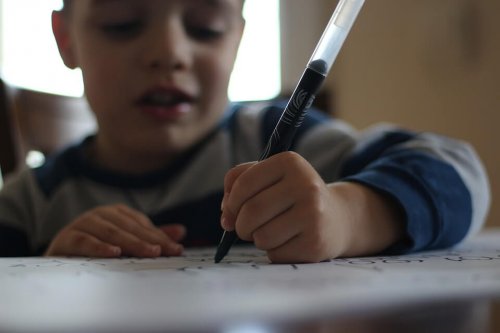Students With Learning Difficulties

It’s common to believe that a child who doesn’t perform well at school isn’t trying hard enough. However, the reasons for this difficulty may be much deeper. Students with learning difficulties need help from their parents, teachers, and tutors in order to make progress in their education.
While it’s true that some children seem to suffer from some kind of allergy when it comes to doing their homework, and getting them to sit down to study takes a lot of work, there are other reasons that can harm their learning process. Not only does it depend on their will and attitude; there are other factors at play as well.
Learning is strictly linked to the way a person’s brain works. Like many other characteristics, this is something that’s genetically determined. That is, complications in assimilating knowledge can be inherited.
Many students with learning difficulties are children of people who experienced the same problems during childhood. Today, technology and the knowledge of specialists make most of these problems absolutely treatable.
The most common learning disabilities
Dyslexia
Related to linguistic knowledge, this condition causes difficulties in learning to read and, to a lesser degree, to write. In certain cases, it can also affect speech.
Students with learning difficulties who suffer from dyslexia manifest, mainly, problems in recognizing and associating letters and their symbols and sounds. This extends, consequently, to the formation of words.

It’s a condition that accompanies the person for life and is usually manifested by the inability to pronounce complex words, to read in sequence, or to produce rhymes.
However, there are many best practices to alleviate this linguistic deficit. Frequent reading is the most prominent.
“Those who suffer from dyslexia manifest problems in recognizing and associating letters and their symbols and sounds.”
Dyscalculia
This has to do with difficulties in processing even simple mathematical calculations. Children with dyscalculia have difficulty identifying numbers, writing them down, copying them, and also have difficulty incorporating basic mathematical concepts.
Dyscalculia is caused by a disability of the brain area responsible for numerical processing, which is the parietal lobe, although the angular gyrus and posterior superior parietal lobe are also involved.
It’s detected between the ages of five and eight, when mathematics is introduced into the school and daily life of children and their performance can be compared with that of others. Its diagnosis requires careful family involvement, as the child’s self-esteem and confidence may be affected by not achieving the tasks expected of them.
Once dyscalculia is diagnosed, the work is personalized, requiring learning therapies and psychotherapy.
Dysgraphia
This condition is often confused with dyslexia. Dysgraphia is a disorder that causes complications in learning to write. Although it’s something that can occur during the early learning of this skill, dysgraphia represents a persistent and frustrating impossibility for the child.
It’s recognized because the child who suffers from it can’t compose, copy, or identify letters. In addition, they may have difficulty manipulating a pencil or typing a word on a device.
The precise causes of dysgraphia aren’t known, although it’s generally thought to be related to genetic or pedagogical issues. Learning therapies may also be used to address it.
Attention Deficit Hyperactivity Disorder
As the name suggests, children with ADHD have great difficulty focusing their attention during class or learning times. They find it difficult to sit still and are extremely impulsive when acting.
This disorder affects more than 5% of children in the world. In addition, it is more common in boys than in girls.

There are three subtypes of ADHD: Inattentive, impulsive, and combined. To be detected, it must be present for 6 months (always from the age of 7, not before) and affect two or more different environments (school and home, for example).
“ADHD affects more than 5% of children in the world.”
How to treat students with learning difficulties?
It’s very rare for a child to notice one of the above-mentioned disorders in themself. That’s why it’s essential for parents to be on top of their child’s learning process and to follow up. The earlier the problem is detected, the more feasible it will be to overcome it.
Students with learning difficulties may feel socially excluded, less valued, or may even suffer serious self-esteem problems because they don’t feel “on the same level” as others.
It’s important, then, to work from a pedagogical and also from the psychological point of view to try to solve learning difficulties. In both cases, the constant support of their family is essential to overcome (or at least cope with) this stage.
It’s common to believe that a child who doesn’t perform well at school isn’t trying hard enough. However, the reasons for this difficulty may be much deeper. Students with learning difficulties need help from their parents, teachers, and tutors in order to make progress in their education.
While it’s true that some children seem to suffer from some kind of allergy when it comes to doing their homework, and getting them to sit down to study takes a lot of work, there are other reasons that can harm their learning process. Not only does it depend on their will and attitude; there are other factors at play as well.
Learning is strictly linked to the way a person’s brain works. Like many other characteristics, this is something that’s genetically determined. That is, complications in assimilating knowledge can be inherited.
Many students with learning difficulties are children of people who experienced the same problems during childhood. Today, technology and the knowledge of specialists make most of these problems absolutely treatable.
The most common learning disabilities
Dyslexia
Related to linguistic knowledge, this condition causes difficulties in learning to read and, to a lesser degree, to write. In certain cases, it can also affect speech.
Students with learning difficulties who suffer from dyslexia manifest, mainly, problems in recognizing and associating letters and their symbols and sounds. This extends, consequently, to the formation of words.

It’s a condition that accompanies the person for life and is usually manifested by the inability to pronounce complex words, to read in sequence, or to produce rhymes.
However, there are many best practices to alleviate this linguistic deficit. Frequent reading is the most prominent.
“Those who suffer from dyslexia manifest problems in recognizing and associating letters and their symbols and sounds.”
Dyscalculia
This has to do with difficulties in processing even simple mathematical calculations. Children with dyscalculia have difficulty identifying numbers, writing them down, copying them, and also have difficulty incorporating basic mathematical concepts.
Dyscalculia is caused by a disability of the brain area responsible for numerical processing, which is the parietal lobe, although the angular gyrus and posterior superior parietal lobe are also involved.
It’s detected between the ages of five and eight, when mathematics is introduced into the school and daily life of children and their performance can be compared with that of others. Its diagnosis requires careful family involvement, as the child’s self-esteem and confidence may be affected by not achieving the tasks expected of them.
Once dyscalculia is diagnosed, the work is personalized, requiring learning therapies and psychotherapy.
Dysgraphia
This condition is often confused with dyslexia. Dysgraphia is a disorder that causes complications in learning to write. Although it’s something that can occur during the early learning of this skill, dysgraphia represents a persistent and frustrating impossibility for the child.
It’s recognized because the child who suffers from it can’t compose, copy, or identify letters. In addition, they may have difficulty manipulating a pencil or typing a word on a device.
The precise causes of dysgraphia aren’t known, although it’s generally thought to be related to genetic or pedagogical issues. Learning therapies may also be used to address it.
Attention Deficit Hyperactivity Disorder
As the name suggests, children with ADHD have great difficulty focusing their attention during class or learning times. They find it difficult to sit still and are extremely impulsive when acting.
This disorder affects more than 5% of children in the world. In addition, it is more common in boys than in girls.

There are three subtypes of ADHD: Inattentive, impulsive, and combined. To be detected, it must be present for 6 months (always from the age of 7, not before) and affect two or more different environments (school and home, for example).
“ADHD affects more than 5% of children in the world.”
How to treat students with learning difficulties?
It’s very rare for a child to notice one of the above-mentioned disorders in themself. That’s why it’s essential for parents to be on top of their child’s learning process and to follow up. The earlier the problem is detected, the more feasible it will be to overcome it.
Students with learning difficulties may feel socially excluded, less valued, or may even suffer serious self-esteem problems because they don’t feel “on the same level” as others.
It’s important, then, to work from a pedagogical and also from the psychological point of view to try to solve learning difficulties. In both cases, the constant support of their family is essential to overcome (or at least cope with) this stage.
All cited sources were thoroughly reviewed by our team to ensure their quality, reliability, currency, and validity. The bibliography of this article was considered reliable and of academic or scientific accuracy.
- Aragón, L. E. (2001). Intervención con niños disléxicos: evaluación y tratamiento. México: Trillas. http://www.trillaseduforma.com/zona-prensa/ficheros/resenas/8466541675.pdf
- de Lima, R. F., Travaini, P. P., Azoni, C. A. S., & Ciasca, S. M. (2012). Atención sostenida visual y funciones ejecutivas en niños con dislexia de desarrollo. Anales de Psicología/Annals of Psychology, 28(1), 66-70. https://revistas.um.es/analesps/article/view/140532
- Geary, D. (2017). La discalculia en edad temprana. Encyclopedia sobre el desarrollo de la primera infancia: Junyi. Tomo problemas de aprendizaje. Recuperado de: http://www. enciclopedia-infantes. com/trastornos-del-aprendizaje/sintesis. http://ceril.net/index.php/articulos?id=475&sfns=mo
- Vázquez, A. J. S., Fonseca, L. D. L. Á. C., Mozo, D. B., & Céspedes, I. T. (2017). La dislexia, la disgrafia y la discalculia: sus consecuencias en la educación ecuatoriana. Revista Archivo Médico de Camagüey, 21(1), 766-772. https://www.medigraphic.com/cgi-bin/new/resumen.cgi?IDARTICULO=70388
- Lores Leyva, I., Calzadilla González, O., Hernández Torres, I., Noguera Núñez, K., & Díaz Pompa, F. (2014). La ayuda logopédica a niños con manifestaciones de dislexia y disgrafia. Correo Científico Médico, 18(1), 18-24. http://scielo.sld.cu/scielo.php?pid=S1560-43812014000100004&script=sci_arttext&tlng=pt
- Urzúa, A., CERDA, A., RAMOS, M., & QUIROZ, J. (2009). Trastorno por déficit de atención con hiperactividad en niños escolarizados. Revista chilena de pediatría, 80(4), 332-338. https://scielo.conicyt.cl/scielo.php?pid=S0370-41062009000400004&script=sci_arttext
- Roselló, B., García Castellar, R., Tárraga Mínguez, R., & Mulas, F. (2003). El papel de los padres en el desarrollo y aprendizaje de los niños con trastorno por déficit de atención con hiperactividad. Revista de Neurologia, 2003, vol. 36, num. Supl. 1, p. 79-84. https://core.ac.uk/reader/71019268
This text is provided for informational purposes only and does not replace consultation with a professional. If in doubt, consult your specialist.








